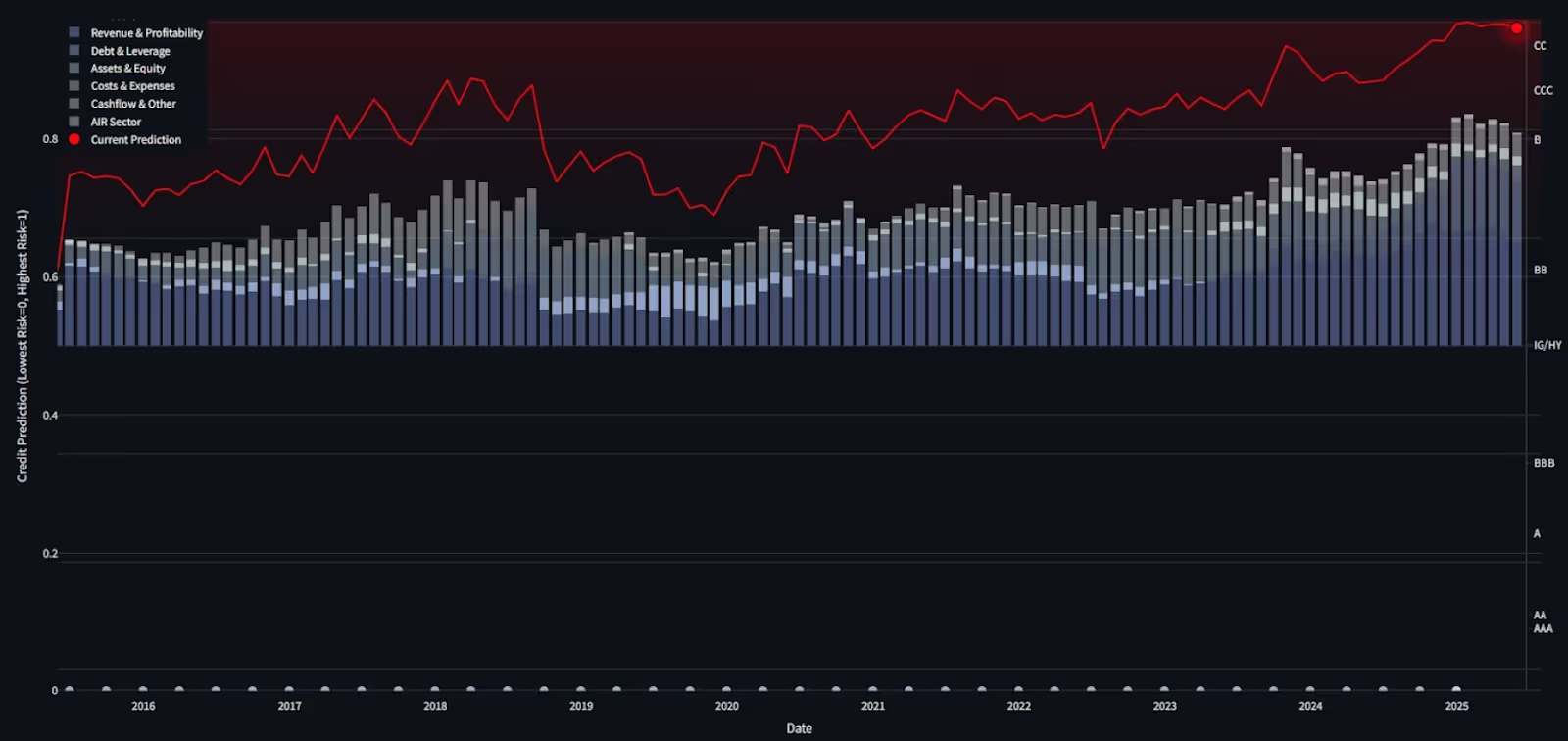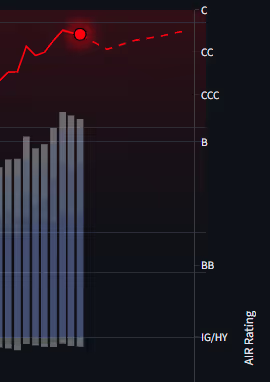
The recent announcement of Wolfspeed’s (WOLF’s) long-anticipated bankruptcy filing means that investors and risk managers are shifting from the “what happened, and when did we know it?” mode to “what’s next?”
In a previous post we addressed the first two questions. As to “when did we know it?”, WOLF’s Risk Score, generated by AIR Platforms’ Predictive AI model, assigned the company a CCC equivalent rating in 2019, a good three years before it last tapped the capital markets (for a $1.25 billion bond issue). We supported this conclusion by showing the drivers of WOLF’s decline, their relative importance, and how they changed over time (the “what happened” piece). As a recap, Figure 1 presents a time series of WOLF’s AIR Credit Risk Score and drivers, starting in 2015. Over this period the Score (a rank order metric of the risk of adverse credit events, shown by the red line) never reached investment grade-equivalent levels.

At some point WOLF’s restructured debt will likely start to trade in the markets. So in this post we turn our attention to how market participants can use AIR Platforms’ AI models to produce reports and forecasts that assess WOLF’s post-bankruptcy outlook, and thus the risks and opportunities of investing in the company.
The foundation of most written analyses is the credit report - a quick summary of the current state of affairs for a given company. AIR Platforms produces credit reports for all publicly traded companies in the U.S. market, updated daily to reflect all relevant credit-specific news, market changes, and company and sector financial factors. Users can extend coverage to private companies by uploading their financial statements, a feature that we will cover in our next post. Regardless of whether a company is private or public, its credit report is oriented around the drivers of its Credit Risk Score, providing an intuitive and easy to interpret link between the two outputs.
To give a flavor of a typical credit report, Figure 2 shows the key financials and ratios influencing WOLF’s Risk Score shortly before the company defaulted.

Given Wolfspeed’s “one foot in the grave” situation at the time, its financial ratios and the dire conclusions that the model draws from them will not be a surprise.
So far we’ve focused on how AIR’s Large Language Models generate reports and data that allow users to analyze WOLF’s current situation. We now turn our attention to how we help market participants game out their next move - the “what’s next?” question we posed at the outset. We do this by calling on one of AIR Platforms’ key features, its AI powered assistant, Credit Agent.
Credit Agent is an interactive function that analysts and portfolio managers use to assess the impact on a company’s creditworthiness of scenarios such as “What happens if the US government raises tariffs on imports from China by 100%?” (relevant for Tesla), or “What happens if the Strait of Hormuz is closed to shipping for 90 days?” (good to know for a global energy company). The results are expressed both in a 12-month forecast Risk Score and in a credit report explaining the forecast’s drivers. This transparency means that unlike most models, Credit Agent is not a “black box”. Indeed, as we demonstrate below, users can interact with it, probing and changing its assumptions and outputs.
Let’s return to Wolfspeed.
WOLF’s bankruptcy restructuring will write down its debt by 70%. A quick query of the Credit Agent tells us that WOLF has $6.5 billion in debt, so the restructuring will eliminate around $4.5 billion in liabilities. Thus the key question for current and potential bondholders is how this will change the company’s credit profile. As mentioned, we can get the answer from the Credit Agent simply by asking “What happens if the company’s debt is reduced by 70%?” The answer, shown in Figure 3, is “not much”. Specifically, the Risk Score’s mapped rating improves for the 12-month forecast period ending March 2026, but only from the equivalent of a single-C to, initially, CC, before it drifts lower once again. A 70% debt reduction would seem to be a big deal; why has WOLF’s Score improved so modestly?

We can answer this question by querying Credit Agent again, this time asking “Why does a 70% reduction in debt result in only a small improvement in WOLF’s credit score?” The resulting output, which is complemented by a list of Key Financial Highlights, is shown in Figure 4:

This all makes sense, given that the company reported almost $1 billion in operating losses in calendar 2024 and had strongly negative cash flow. So reducing debt alone, while a positive step as the model notes, does not change the outlook for these metrics in meaningful ways. This is valuable information for anyone considering a post-restructuring investment in WOLF.
No one and no system can predict the future with complete accuracy, of course. A key part of the job for credit analysts and portfolio managers is making tough calls like whether an investment in Wolfspeed post-restructuring will pay off. Having an intelligent assistant like Credit Agent doesn’t change this. But by its ability to generate forecasts and run scenarios in seconds rather than the hours it would take to perform these tasks manually, AIR’s Credit Agent serves as a powerful assistant for credit practitioners, freeing up their time so they can focus on higher value-added activities for their firm and their clients.
To learn more, please follow us on Linkedin and check out our site: https://www.airplatforms.com/product
Disclaimer
The information provided (including ratings, credit scores, risk drivers, financial information and news summaries) is for informational purposes only and should not be construed as financial, investment, or other professional advice, or as a recommendation to buy, sell, or hold any security. This information is generated in part by AI models, and may contain errors, omissions or biases inherent in AI systems and/or the underlying data. This information is provided “AS IS” without any warranties. You are solely responsible for any decisions made or actions taken in reliance on this information, assume all associated risks and should conduct your own independent research and due diligence.